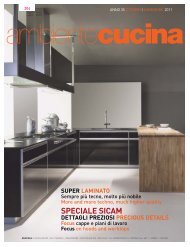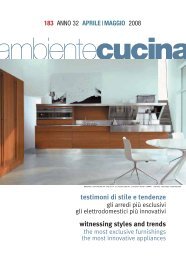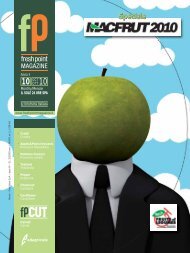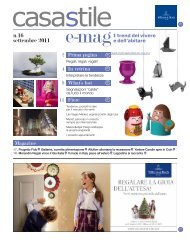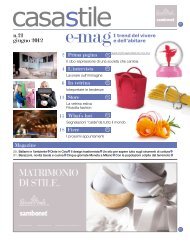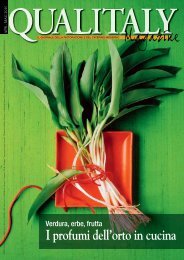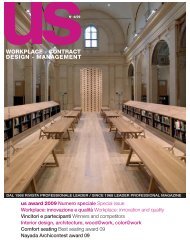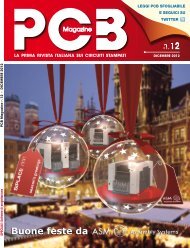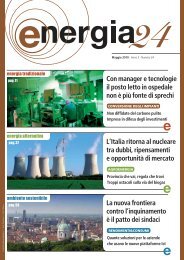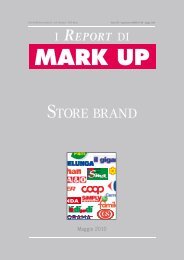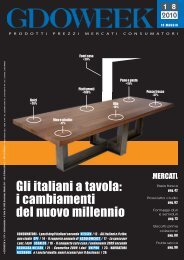Fresh Point Magazine - B2B24 - Il Sole 24 Ore
Fresh Point Magazine - B2B24 - Il Sole 24 Ore
Fresh Point Magazine - B2B24 - Il Sole 24 Ore
You also want an ePaper? Increase the reach of your titles
YUMPU automatically turns print PDFs into web optimized ePapers that Google loves.
isr/merchandising<br />
gdo/merchandising<br />
longer is it a mere container for merchandise but,<br />
rather, a narrative display of items. «In effect, ours is an<br />
age – noted Maria Angela Polesana of Brand Lab and<br />
Business Communications at Milan’s Iulm University –<br />
that has seen the retail outlet transformed from point of<br />
purchase into point of pleasure. In other words, it has<br />
become a place that sharpens our awareness and elicits<br />
emotional responses through a multi-sensory experience<br />
encountered in meeting point, that is, a place<br />
stimulating emotional and relational responses.<br />
Colours, smells, music and touch are the grammar of a<br />
narrative stream the retail outlet develops through a<br />
kind of story line that consumers themselves contribute<br />
to by reimagining the outlet through their felt<br />
perceptions. Indeed, the new consumer no longer asks<br />
“What can I buy that I haven’t got yet”, but “What can<br />
I experience that I haven’t tried yet”».<br />
This experiencing of the retail outlet cuts across all merchandise<br />
categories and represents one of the new fields<br />
of marketing research. Even the F&V floor is changing<br />
look in reaching out to the new consumer, or in<br />
Polesana’s better definition consumActor: «In comparing<br />
products whose performance and flavour characteristics<br />
are increasingly similar, what makes the difference are<br />
the intangibles, the symbolic realm of things. Indeed, our<br />
very first act of buying is like completing an apprenticeship<br />
in today’s consumer society and, while we can then<br />
boast a certain expertise in discerning between the various<br />
items on sale, it is the technological revolution above<br />
all that has provided an ever increasing amount of such<br />
that we keep becoming ever more demanding».<br />
The need to be reassured<br />
The produce industry has of late been marked by two<br />
Wholefood’s model<br />
<strong>Il</strong> modello Wholefood’s<br />
60 <strong>Fresh</strong> <strong>Point</strong> <strong>Magazine</strong> n.11 – november/novembre 2011<br />
Whole Foods Market is a pleasurable place even when the<br />
shopping is done.<br />
<strong>Il</strong> Whole Foods Market è uno spazio piacevole anche dopo aver fatto<br />
la spesa.<br />
delle nuove branche di ricerca del marketing. Anche il<br />
reparto ortofrutticolo sta quindi cambiando volto per<br />
raggiungere un nuovo consumatore, meglio definito da<br />
Polesana consumAttore: «A fronte di prodotti sempre<br />
più simili quanto a performances e caratteristiche<br />
organolettiche sono le dimensioni intangibili, simboliche<br />
a fare la differenza. Chi acquista, infatti, ha compiuto<br />
ormai il suo apprendistato nel mondo dei consumi<br />
e può quindi vantare una certa competenza nel<br />
muoversi tra le varie offerte, ma è soprattutto la rivoluzione<br />
tecnologica che lo ha fornito di un numero sempre<br />
crescente d’informazioni tali da renderlo più esigente,<br />
selettivo, demanding».<br />
Bisogno di rassicurazione<br />
Negli ultimi anni il settore ortofrutticolo è stato caratteriz-<br />
Following the hypermarket boom in the 1990s, when big retail focused only on increasing the number of items displayed over<br />
vast floor spaces in whose aisles consumers wandered as if in a kind of food city guided merely by indications as to product<br />
type posted in the various departments, today the big chains are looking more closely at creating a shopping ambience with a<br />
more pronounced welcome mat.<br />
US-based Wholefood’s offers a good case in point regarding the nature of the new kind of shopping experience, according to<br />
Maria Angela Polesana of Milan’s Iulm University. «It’s a concept that’s clearly the part of the mission regarding company social<br />
responsibility and its pronounced effort in education and relations in which the focus is squarely on the consumer as pro-active<br />
partner and not a passive receptor». (DV)<br />
Dopo il boom degli ipermercati, negli anni Novanta, dove si puntava solo al numero delle referenze esposte su immense superfici,<br />
nelle quali il consumatore si muoveva tra le corsie come in una sorta di città del food guidato dalle indicazioni delle tipologie di prodotti<br />
che si trovavano nei vari reparti, oggi la moderna distribuzione guarda con maggiore attenzione alla creazione di un ambiente di<br />
acquisto più accogliente.<br />
L’americana Wholefood’s offre un buon esempio di concretizzazione dell’esperienzialità nel punto vendita afferma Maria Angela<br />
Polesana dell’Università Iulm di Milano: «Un concetto chiaramente espresso nella mission, all’insegna proprio della responsabilità<br />
sociale e della funzione educativa e di relazione spinta rispetto al consumatore posto al centro dell’attenzione: interlocutore attivo e<br />
non passivo recettore». (JP)



